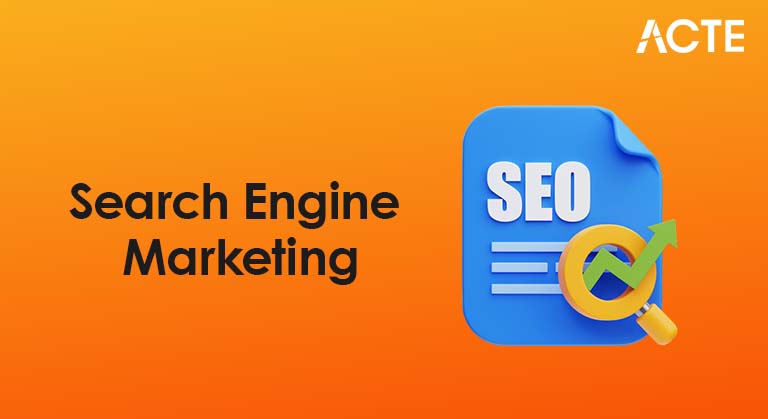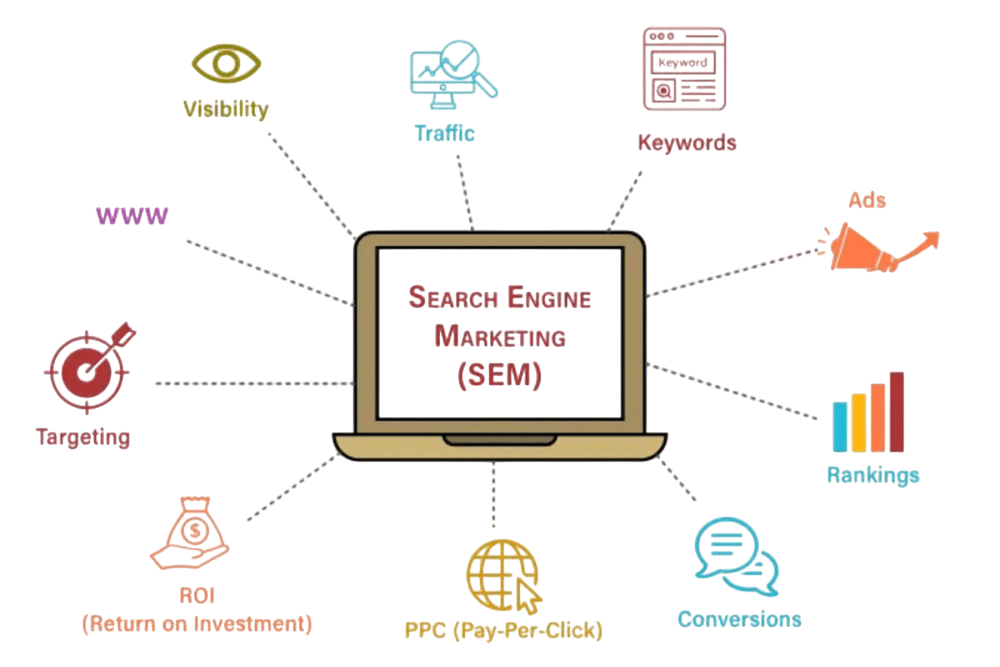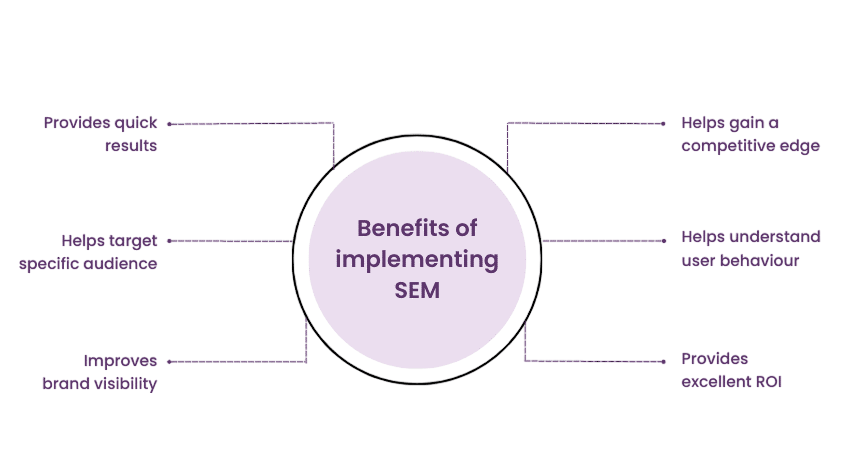
- Introduction
- What is SEM?
- Difference Between SEO and SEM
- Core Components of SEM
- The Benefits of SEM
- The Importance of SEM for Businesses Today
- SEM in the Buyer’s Journey
- Industry Use Cases
- Conclusion
Introduction
Any company hoping to expand and compete in today’s digitally first world must have a strong online presence. SEM, or search engine marketing, is one of the best methods for doing this. Increasing a website’s visibility on search engine results pages (SERPs) through paid advertising is known as search engine marketing (SEM). By displaying advertisements in front of customers who are actively looking for related goods or services,Importance of SEM produces quicker results than Search Engine Optimization (SEO), which concentrates on organic rankings. SEM enables firms to engage with potential clients at the ideal time when they are already expressing interest by focusing on particular demographics and keywords. SEM may be an effective tool for small business owners and major brands alike to boost traffic, SEM may be a very effective technique for increasing traffic, Digital Marketing Training brand awareness, and conversions, regardless of the size of your company. Visibility is crucial in the world of digital marketing. Companies must give their search engine ranking top priority if they wish to connect with clients online. SEM, or search engine marketing, is now a crucial part of this plan. By putting advertisements in front of highly interested audiences, SEM provides a potent supplement to SEO, which is what many firms rely on for organic visibility. The main advantages and strategic significance of SEM in the cutthroat online environment of today are examined in this essay.
Ready to Get Certified in Digital Marketing? Explore the Program Now Digital Marketing Online Training Offered By ACTE Right Now!
What is SEM?
Search Engine Marketing (SEM) refers to paid advertising strategies on search engines like Google, Bing, and Yahoo. Unlike SEO, which focuses on organic rankings, SEM involves paying for ad placements that appear at the top or bottom of search engine results pages (SERPs).These ads are typically text-based and triggered by specific keywords that users type into search engines. Google Ads is the most widely used SEM platform, allowing businesses to bid on keywords and display targeted ads to users based on search intent.Search Engine Marketing, commonly known as SEM, is a digital marketing strategy used to increase a website’s visibility on search engine results pages (SERPs) through paid advertising. It involves creating and managing ads that appear when users search for specific keywords related to a business, product, or service. SEM uses paid techniques like pay-per-click (PPC) advertising to provide results right away, in contrast to Search Engine Optimization (SEO), CC and BCC in Emails which concentrates on raising organic rankings by optimizing the content and structure of websites. On search engines like Google, Bing, and Yahoo, advertisers place bids on keywords that are pertinent to their target market. In order to make sure that prospective buyers see the advertisements first when looking for similar phrases, SEM positions them at the top or bottom of search results. Advertising is a cost-effective way to bring targeted traffic to a website because advertisers only pay when someone clicks on their ad. PPC advertising is the most popular name for this model.

Targeting particular audiences according to region, language, device, and even time of day is one of SEM’s greatest benefits. Businesses may increase conversions and sales by using precision targeting to reach the appropriate customers at the right time. Through in-depth analytics, SEM not only increases traffic but also offers insightful information. Real-time tracking of ad performance allows advertisers to make necessary adjustments to optimize budgets, boost ROI, Become a Content Writer and improve results. Because SEO might take months to provide results, SEM is especially helpful for new companies or websites that want to be seen right away. SEM and SEO work together to create a potent digital marketing plan that targets both organic and sponsored search traffic.
Difference Between SEO and SEM
Many people confuse SEM with SEO, but they serve distinct functions:
| Feature | SEO | SEM |
|---|---|---|
| Cost | Free (organic traffic) | Paid (per click or impression) |
| Speed | Long-term growth | Immediate results |
| Placement | Organic search listings | Sponsored/paid search listings |
| Longevity | Sustainable over time | Short-term impact |
Both strategies are valuable, but SEM delivers faster, more targeted visibility especially for time-sensitive campaigns.
To Explore Digital Marketing in Depth, Check Out Our Comprehensive Digital Marketing Training To Gain Insights From Our Experts!
Core Components of SEM
Search Engine Marketing (SEM) is a multifaceted strategy that involves several key components working together to ensure effective paid search campaigns. Understanding these core elements helps businesses optimize their efforts and maximize results. The main components of SEM include:
- Keyword Research: The cornerstone of SEM is keyword research. Finding the search phrases that prospective clients use to find goods or services is part of this procedure. By selecting pertinent, high-intent keywords that strike a balance between search volume and competition, effective keyword research aids in identifying the ideal audience.
- Ad Creation: Ads must be relevant and engaging in order to get clicks. Typically, advertisements consist of a call-to-action (CTA), description, and headline. Writing compelling copy that supports the user’s search purpose, promotes interaction, and emphasizes the USPs is the aim.
- Bidding Strategy: SEM uses a bidding system in which advertisers vie for ad spots according to bid amounts and keyword relevancy. Ad expenditure can be optimized and return on investment (ROI) increased by selecting the appropriate bidding technique, such as improved CPC, automatic bidding, Digital Marketing Training or manual CPC (cost-per-click).
- Landing Pages: Users are taken to a landing page after clicking on an advertisement. In order to turn visitors into customers whether through sales, sign-ups, or inquiries the landing page needs to be pertinent, easy to use, and optimized.
- Campaign Management and Optimization: Continuous campaign monitoring and improvement are essential. This includes examining performance data, modifying bids, experimenting with various ad copy, and honing keywords in order to increase click-through rates (CTR), conversion rates, and the overall efficacy of campaigns.
- Analytics and Reporting: Google Ads and Analytics are two examples of tracking systems that offer comprehensive insights into the effectiveness of campaigns. Marketers may analyze success and make data-driven decisions with the aid of metrics like impressions, clicks, cost per conversion, ROI, and CTR.
The Benefits of SEM
- Instant Visibility: Unlike SEO, which can take months to yield results, SEM places your brand at the top of search results immediately after launching a campaign. This is especially beneficial for new websites, product launches, and seasonal promotions.
- High-Intent Audience Targeting: People using search engines are already looking for something specific. SEM lets you reach users based on their intent, making it more likely they will convert. For instance, someone searching for “best accounting software” is already interested in making a purchase or comparison.
- Measurable Results: SEM platforms like Google Ads provide detailed analytics on every aspect of your campaign, including impressions, clicks, click-through rates (CTR), conversions, Google Algorithm Updates and cost per acquisition (CPA). This data allows you to optimize your strategy continuously.
- Cost Control and ROI: SEM offers flexible budgeting. You can set daily or monthly limits, choose between CPC (cost per click) or CPM (cost per thousand impressions), and pause campaigns anytime. Properly managed SEM campaigns often generate strong ROI because they target users actively seeking your product or service.
- Enhances Brand Awareness: Even when users don’t click your ad, they still see your brand name. Over time, this builds brand recall. Paid ads increase your visibility, especially for branded and competitive keywords.
- Geo-Targeting Opportunities: SEM allows you to target specific geographic locations, down to cities or even zip codes. This is particularly beneficial for local businesses or companies with region-specific offerings.
- Complements Other Marketing Strategies: SEM works well alongside SEO, social media, email marketing, and content marketing. While other channels may generate leads passively, SEM brings immediate traffic that helps test offers, Customer Persona messaging, and landing page effectiveness quickly.

Looking to Master Digital Marketing? Discover the Digital Marketing Expert Masters Program Training Course Available at ACTE Now!
The Importance of SEM for Businesses Today
In a world where attention spans are short and competition is fierce, SEM provides a vital edge. Here’s why it’s essential:
- Digital-first behavior: Most consumers start their purchase journey with a search engine. If your brand isn’t showing up in these moments, you risk losing potential customers to competitors.
- Competitive industries: In saturated markets, organic ranking alone may not be enough. SEM helps brands break through the clutter.
- Mobile usage: More than half of web traffic now comes from mobile. SEM allows businesses to target mobile users with optimized ads and responsive landing pages.
By capitalizing on real-time searches, Your Target Audience SEM ensures your brand is visible exactly when people are looking for what you offer.
SEM in the Buyer’s Journey
Search Engine Marketing (SEM) plays a crucial role at every stage of the buyer’s journey by connecting potential customers with relevant information exactly when they need it. In the awareness stage, SEM helps businesses capture attention by targeting broad keywords related to common problems or needs, introducing their brand to users who are just beginning to explore solutions. Moving into the consideration stage, SEM campaigns become more focused, targeting specific keywords that reflect the buyer’s intent to compare options or research products. Here, well-crafted ads can highlight unique features, benefits, or special offers that set a business apart from competitors. Finally, in the decision stage, SEM targets high-intent, Content Distribution action-oriented keywords, driving users toward conversion with compelling calls-to-action, such as “buy now” or “sign up today.” By aligning ad strategies with the buyer’s journey, SEM ensures that businesses deliver the right message at the right time, increasing the likelihood of engagement and ultimately, sales.
Industry Use Cases
Search Engine Marketing (SEM) is widely used across various industries to drive targeted traffic and boost conversions. In e-commerce, SEM helps online retailers promote products and attract buyers actively searching for specific items. Healthcare providers use SEM to reach patients looking for medical services or specialists, Big Brands Transforming Experience often focusing on local searches. The travel and hospitality sector leverages SEM to capture travelers planning trips by targeting keywords like “cheap flights” or “hotel deals.” Real estate agents use SEM to generate leads by advertising property listings to local buyers or renters. Educational institutions attract prospective students by promoting courses and enrollment periods through targeted ads. Additionally, professional service providers such as lawyers and consultants use SEM to connect with clients seeking specialized services. Across these diverse industries, SEM enables businesses to deliver the right message at the right time, driving engagement and growth effectively.
Preparing for Digital Marketing Job Interviews? Have a Look at Our Blog on Digital Marketing Interview Questions and Answers To Ace Your Interview!
Conclusion
Search Engine Marketing offers a direct, measurable, and highly effective way to connect with potential customers when they are actively seeking solutions. From its ability to generate immediate traffic to its precise targeting and flexible budget control, SEM is an indispensable tool in a modern marketer’s arsenal. Businesses that invest in SEM gain visibility, Digital Marketing Training drive conversions, and increase revenue often with quicker results than other marketing channels. Whether you’re a startup or a global enterprise, incorporating SEM into your digital strategy can unlock new levels of growth and competitive advantage. If you haven’t yet explored the full potential of SEM, now is the time to start. With thoughtful planning, strategic execution, Core Components of SEM and continuous optimization, the benefits are too powerful to ignore.




